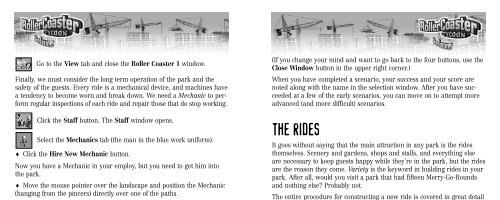o_18sdbeiuo3t0rpqfql1c9o1fuva.pdf
Create successful ePaper yourself
Turn your PDF publications into a flip-book with our unique Google optimized e-Paper software.
Removing Rides<br />
After you’ve built an attraction, you<br />
can choose to demolish it (using the<br />
Construction button in the Ride<br />
window). When you do so with a newly<br />
built ride or shop, you normally get a<br />
full refund of the cost of building.<br />
However, once you’ve opened the ride<br />
(or shop) and your guests have begun<br />
patronizing it, you can no longer<br />
recoup your entire investment. If you<br />
demolish a “used” attraction, your<br />
refund is considerably less.<br />
The rides are organized into several<br />
types, and each type includes<br />
many different rides. (Some of<br />
these are not available for construction<br />
until your research staff<br />
have come up with a safe design.)<br />
Each has its own benefits and<br />
drawbacks, and each appeals to a<br />
certain type of park guest — its<br />
specific target audience. What<br />
draws a person to a ride depends<br />
on the proclivities of that person.<br />
Some guests want an intense,<br />
thrilling, gut-wrenching experience,<br />
while others want to relax and<br />
watch the scenery go by. Often, the decision whether to visit a ride is driven<br />
by price considerations. Even the distance between rides can matter; a<br />
guest who is tired from walking is less likely to want to do anything, but if<br />
your rides are too close together, the park might seem crowded. There are<br />
many things to think about when deciding what type of ride to build.<br />
Design Tips<br />
♦ A transport ride is a great way<br />
to ferry guests to and from a<br />
newly opened area of the park to which<br />
you want to draw interest.<br />
As an added benefit, you can<br />
charge them to get there!<br />
♦ Don’t be too ambitious too soon.<br />
A giant transport network connecting<br />
the entire park will be expensive to<br />
build. Build it in sections, and let the<br />
completed sections run while you save<br />
up funds to build the next one and,<br />
eventually, connect them all.<br />
♦ Transport rides with covered cars are<br />
popular when it’s raining.<br />
Transport Rides<br />
These are the<br />
mildest of the<br />
mild. (In fact, in<br />
some people’s<br />
eyes, they’re<br />
not rides at all.)<br />
Transport rides carry guests along<br />
a fixed track through scenic areas,<br />
and they provide a low-thrill experience<br />
suitable for even the most<br />
squeamish guests. They also act<br />
as an alternative to walking. Any<br />
transport ride can have multiple<br />
stations, and guests use the ride to<br />
travel from one station to the<br />
other — and from one area of the<br />
When you build a transport ride, it’s always a custom design. (Please refer<br />
to the Building a Custom Ride section for the details on constructing one<br />
of these.) Make sure to read the specifications of the ride in the Ride<br />
Selection window before you begin construction. For example, some<br />
transport rides (like trains) run in only one direction and must travel a circuit,<br />
while others (like a monorail) can move back and forth on a single<br />
line of track.<br />
Design Tips<br />
♦ Elevated rides allow your guests<br />
to see other rides and areas of the<br />
park, which can spark interest<br />
in visiting them.<br />
♦ Covered rides are more popular<br />
when it’s raining.<br />
♦ Rides that provide music often<br />
add to the atmosphere of the park,<br />
cheering nearby guests.<br />
Mild Rides<br />
Low-thrill attractions<br />
are the bread<br />
and butter of traveling<br />
carnivals, but<br />
in a park like<br />
yours, they often<br />
play second fiddle to the giant roller<br />
coasters. That doesn’t mean you won’t<br />
see a profit from these. Many guests<br />
have little tolerance for intense rides,<br />
and prefer something more calm.<br />
Most mild rides do not involve custom design, and they tend to take up<br />
less space than the more intense attractions. They rarely make guests<br />
sick, so you can build them near food service stalls without worry.<br />
Roller Coasters<br />
It will come as no surprise to you that the roller coasters<br />
are the primary attraction in most parks. Coasters come<br />
in many types, starting with the old-style wooden tracks<br />
and progressing through steel to the newer inverted,<br />
hanging, standing, corkscrew, single rail, and many<br />
other bizarre permutations. What all of them have in<br />
common is that they strive to provide a hair-raising experience, but also<br />
walk that fine line between exhilaration and discomfort (or terror). A ride<br />
that is too intense gets no riders.<br />
For every different type of roller coaster, there is at least one standard<br />
design. You can also, of course, create a custom coaster. (Please refer to the<br />
park to another.<br />
16 The Rides<br />
The Rides 17




